1. Physical Properties of Metals and Non-Metals
- Books Name
- Chemistry Class 10 NCERT based
- Publication
- Grow Career Publication
- Course
- CBSE Class 10
- Subject
- Chemistry
Metals: Physical properties of metals, chemical properties of metals and non-metal oxide.
Metals are the elements that conduct heat and electricity and are malleable and ductile. Examples are Iron (Fe), Aluminium (Al), Silver (Ag), Copper (Cu), Gold (Au), Platinum (Pt), Lead (Pb), Potassium (K), Sodium (Na), Calcium (Ca) and Magnesium (Mg) etc.
Metals are the elements which form positive ions by losing electrons. Thus, metals are known as Electropositive Elements.
How Do Metals and Nonmetals React
Metals lose valence electron(s) and form cations.
Non-metals gain those electrons in their valence shell and form anions.
The cation and the anion are attracted to each other by strong electrostatic force, thus forming an ionic bond.
For example: In calcium chloride, the ionic bond is formed by opposite charged calcium and chloride ions.
Calcium atom loses 2 electrons and attains the electronic configuration of the nearest noble gas (Ar). By doing so, it gains a net charge of +2.
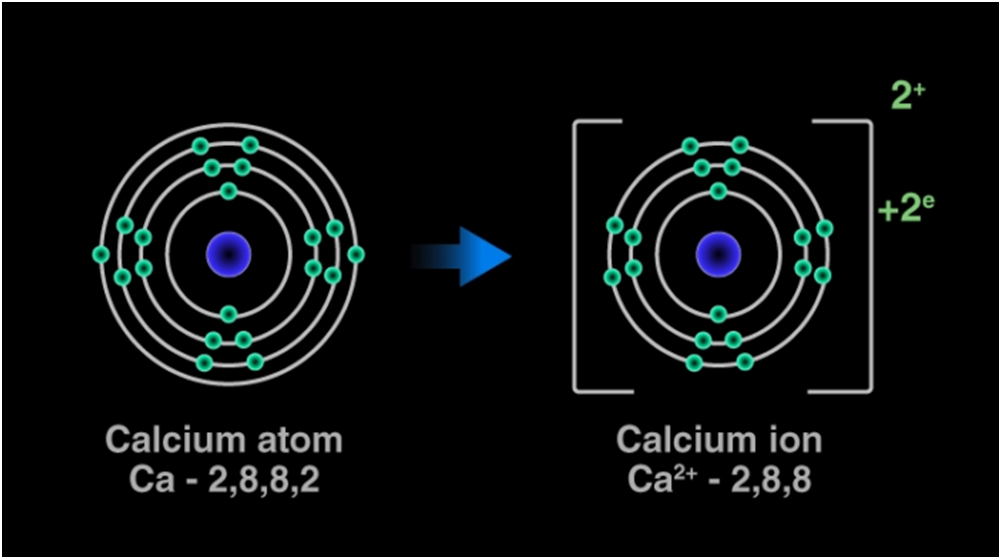
The two Chlorine atoms take one electron each, thus gaining a charge of -1 (each) and attain the electronic configuration of the nearest noble gas (Ar).
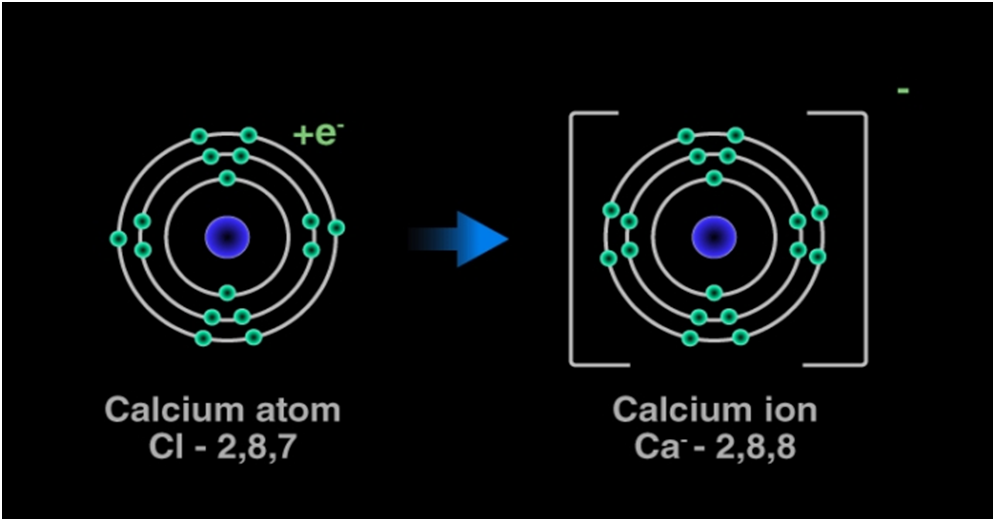
Physical Properties of Metals
- Hardness: Most of the metals are hard, except alkali metals, such as sodium, potassium, lithium, etc. are very soft metals. These can be cut by using a knife.
- Conduction: Metals are a good conductor of heat and electricity. This is the cause that electric wires are made of metals like copper and aluminium.
- Melting and Boiling Point: :Metals have generally high melting and boiling points. (Except sodium and potassium metals which have low melting and boiling point.)
- Strength: Most of the metals are strong and have high tensile strength. Because of this, big structures are made using metals, such as copper (Cu) and iron (Fe). (Except Sodium (Na) and potassium (K) which are soft metals).
- State: Metals are solid at room temperature except for mercury (Hg).
- Malleability: Metals are malleable. This means metals can be beaten into a thin sheet. Because of this property, iron is used in making big ships.
- Ductility: Metals are ductile. This means metals can be drawn into thin wire. Because of this property, a wire is made of metals.
- Density: Most of the metals have a high density.
- Colour: Most of the metals are grey in colour. But gold and copper are exceptions.
Non-Metals: Physical Properties of non-metals, chemical properties of non-metals, non¬metal oxides, Reaction of metal and Non-metal, Ionic bonds and formation of an ionic bond. Non-metals are the elements that do not conduct electricity and are neither malleable nor ductile.
Examples: Carbon (C), Sulphur (S), Phosphorous (P), Silicon (Si), Hydrogen (H), Oxygen (O), Nitrogen (N), Chlorine (Cl), Bromine (Br), Neon (Ne) and Argon (Ar) etc.
Non-metals are the elements which form negative ions by gaining an electron. Thus, non¬metals are also known as Electronegative Elements.
Physical properties of non-metals
- Hardness: Non-metals are not hard rather they are generally soft. But the diamond is an exception; it is the hardest naturally occurring substance.
- State: Non-metals may be solid, liquid or gas.
- Lustre: Non-metals have a dull appearance. Diamond and iodine are exceptions.
- Sonority: Non-metals are not sonorous, i.e., they do not produce a typical sound on being hit.
- Conduction: Non-metals are a bad conductor of heat and electricity. Graphite which is allotrope of carbon is a good conductor of electricity and is an exception.
- Malleability and ductility: Non-metals are brittle.
- Melting and boiling point: Non-metals have generally low melting and boiling points.
- Density: Most of the non-metals have low density.
- Colour: Non-metals are in many colours.
Carbon in the form of graphite is non-metal which conduct electricity.
Iodine is non-metal which is lustrous having a shining surface.
Carbon in the form of diamond is a non-metal which is extremely hard.
Diamond is a non-metal which has a very high melting point and boiling point.
2. Chemical Properties of Metals
- Books Name
- Chemistry Class 10 NCERT based
- Publication
- Grow Career Publication
- Course
- CBSE Class 10
- Subject
- Chemistry
Chemical Properties of Metals
1. Reaction with oxygen: Most of the metals form respective metal oxides when reacting with oxygen.
Metal + Oxygen → Metal Oxide
Examples:
Reaction of Potassium with Oxygen: Potassium metal forms potassium oxide when reacts with oxygen.

Reaction of Sodium with Oxygen: Sodium metal forms sodium oxide when reacts with oxygen.

Reaction of Copper metal with Oxygen: Copper does not react with oxygen at room temperature but when burnt in air, it gives oxide.

Silver, gold and platinum do not combine with the oxygen of air even at high temperature. They are the least reactive.
2. Reaction of metals with water: Metals form respective hydroxide and hydrogen gas when reacting with water.
![]()
Metal + Water → Metal hydroxide + Hydrogen
Reaction of Sodium metal with Water: Sodium metal forms sodium hydroxide and liberates hydrogen gas along with lot of heat when reacting with water.

Reaction of Iron with Water: Reaction of iron with cold water is very slow and comes into notice after a long time. Iron forms rust (iron oxide) when reacts with moisture present in the atmosphere. Iron oxide and hydrogen gas are formed by passing of steam over iron metal.
3. Reaction of metals with dilute acid: Metals form respective salts when reacting with dilute acid. Reaction of Sodium metal with dilute hydrochloric acid: Sodium metal gives sodium chloride and hydrogen gas when react with dilute hydrochloric acid.
![]()
![]()
Hydrogen gas is not when metal is treated with nitric acid (HNO3):
Nitric acid is strong oxidising agent and it oxidises the hydrogen gas (H2) liberated into water (H2O) and itself get reduced to some oxide of nitrogen like nitrous oxide (N2O)3 nitric oxide (NO) and nitrogen dioxide (NO2).
Copper, gold, silver are known as noble metals. These do not react with water or dilute acids.
The order of reactivity of metal towards dilute hydrochloric acid or sulphuric acid is in the order;
K > Na > Ca > Mg > Al > Zn > Fe > Cu > Hg > Ag
Metal Oxides
Chemical Properties: Metal oxides are basic in nature. The aqueous solution of metal oxides turns red litmus blue.
Reaction of Metal oxides with Water: Most of the metal oxides are insoluble in water. Alkali metal oxides are soluble in water. Alkali metal oxides give strong base when dissolved in water.

Reaction of Sodium oxide with Water: Sodium oxide gives sodium hydroxide when reacts with water.
Reaction of Zinc oxide and Aluminium oxide: Aluminum oxide and zinc oxide are insoluble in water. Aluminium oxide and zinc oxide are amphoteric in nature. An amphoteric substance shows both acidic and basic characters. It reacts with base like acid and reacts with an acid like a base.

When zinc oxide reacts with sodium hydroxide, it behaves like an acid. In this reaction, sodium zincate and water are formed
Reactivity Series of Metals: The order of intensity or reactivity of metal is known as Reactivity Series. Reactivity of elements decreases on moving from top to bottom in the given reactivity series. In the reactivity series, copper, gold, and silver are at the bottom and hence, least reactive. These metals are known as Noble metals.
Reactivity of some metals are given in descending order :
K > Na > Ca > Mg > Al > Zn > Fe > Pb > Cu
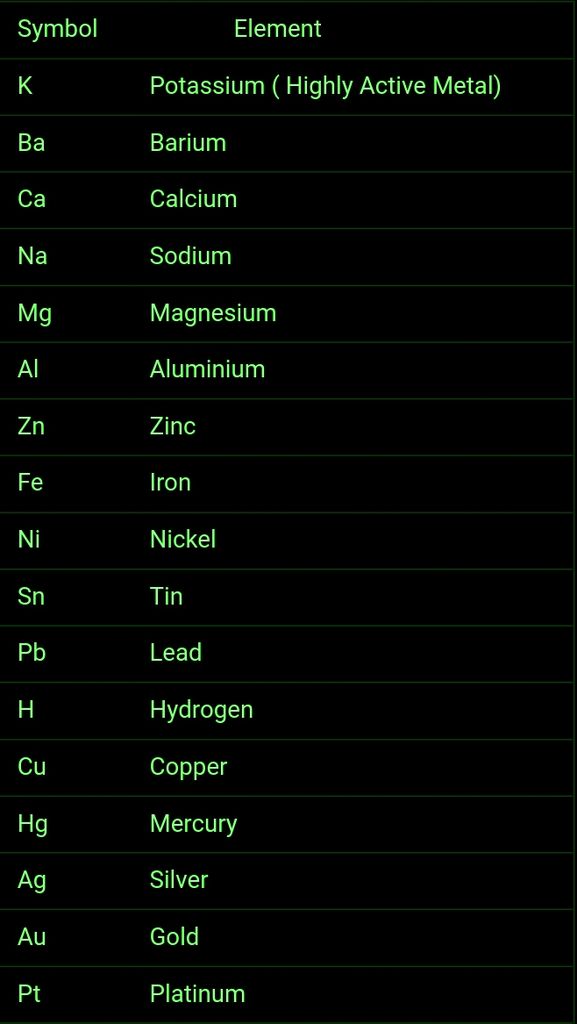
3. Metals and Non-Metals Reactions
- Books Name
- Chemistry Class 10 NCERT based
- Publication
- Grow Career Publication
- Course
- CBSE Class 10
- Subject
- Chemistry
Ionic Compounds
The electrostatic attractions between the opposite charged ions hold the compound together.
Example: MgCl2, CaO, MgO, NaCl etc.
Properties of Ionic Compound
Ionic compounds
- Are usually crystalline solids (made of ions).
- Have high melting and boiling points.
- Conduct electricity when in aqueous solution and when melted.
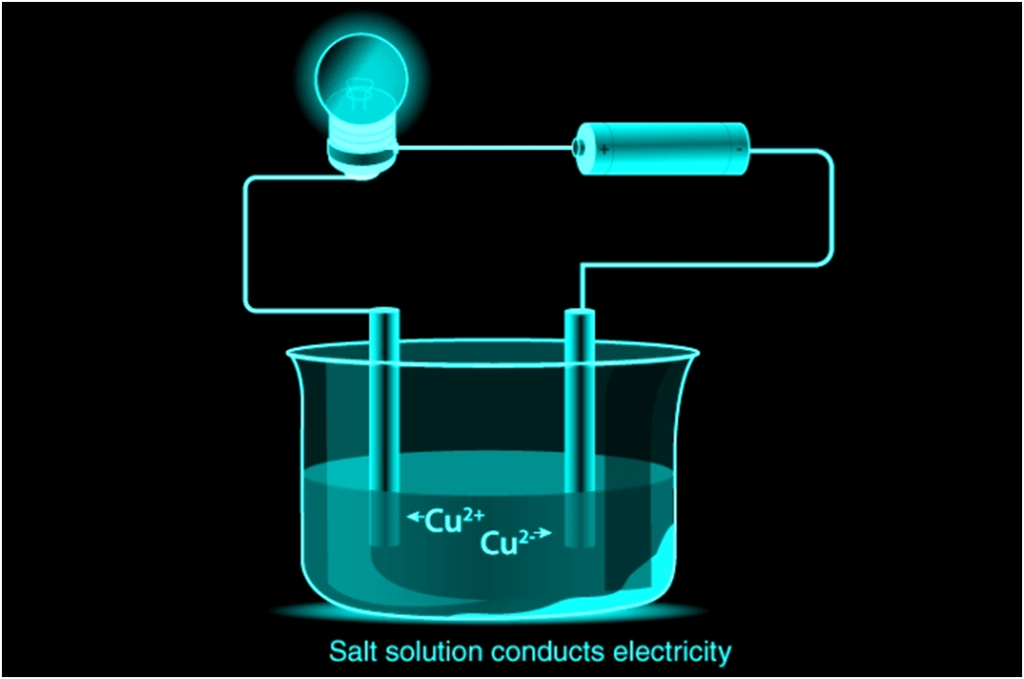
Physical Nature
Ionic solids usually exist in regular, well-defined crystal structures.
Electric Conduction of Ionic Compounds
Ionic compounds conduct electricity in the molten or aqueous state when ions become free and act as charge carriers.
In solid form, ions are strongly held by electrostatic forces of attractions and are not free to move; hence do not conduct electricity.
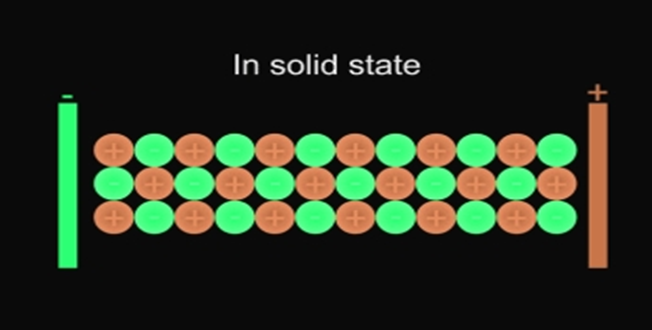
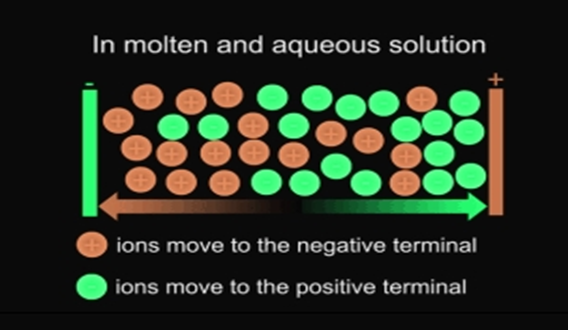
For example, ionic compounds such as NaCl does not conduct electricity when solid but when dissolved in water or in a molten state, it will conduct electricity.
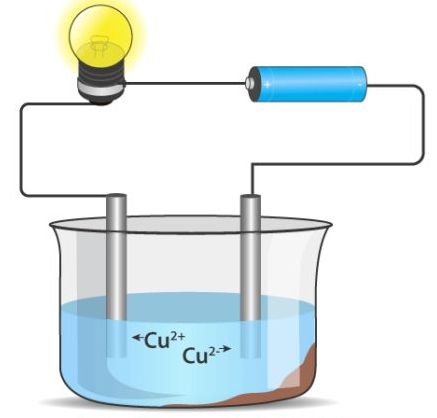
Melting and Boiling Points of Ionic Compounds
In ionic compounds, the strong electrostatic forces between ions require a high amount of energy to break. Thus, the melting point and boiling point of an ionic compound are usually very high.
Solubility of Ionic Compounds
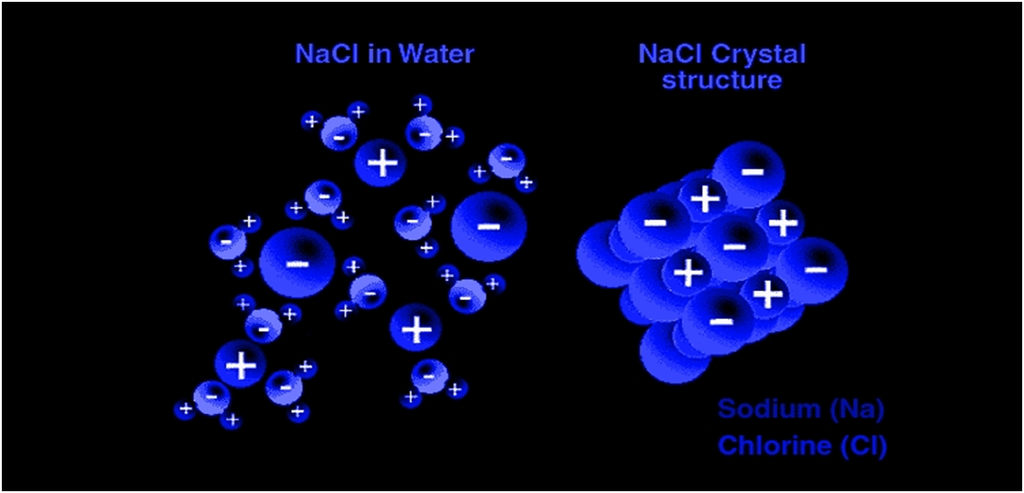
Most ionic compounds are soluble in water due to the separation of ions by water. This occurs due to the polar nature of water.
For example, NaCl is a 3-D salt crystal composed of Na+ and Cl− ions bound together through electrostatic forces of attractions. When a crystal of NaCl comes into contact with water, the partial positively charged ends of water molecules interact with the Cl− ions, while the negatively charged end of the water molecules interacts with the Na+ ions. This ion-dipole interaction between ions and water molecules assist in the breaking of the strong electrostatic forces of attractions within the crystal and ultimately in the solubility of the crystal.
.Properties of Ionic compound
- Ionic compounds are solid. Ionic bond has a greater force of attraction because of which ions attract each other strongly. This makes ionic compounds solid.
- Ionic compounds are brittle.
- Ionic compounds have high melting and boiling points because force of attraction between ions of ionic compounds is very strong.
- Ionic compounds generally dissolve in water.
- Ionic compounds are generally insoluble in organic solvents; like kerosene, petrol, etc.
- Ionic compounds do not conduct electricity in the solid state.
4. Occurence of Metals
- Books Name
- Chemistry Class 10 NCERT based
- Publication
- Grow Career Publication
- Course
- CBSE Class 10
- Subject
- Chemistry
Occurrence of Metals
Most of the elements, especially metals occur in nature in the combined state with other elements. All these compounds of metals are known as minerals. But out of them, only a few are viable sources of that metal. Such sources are called ores.
Au, Pt – exist in the native or free state.
Extraction of Metals
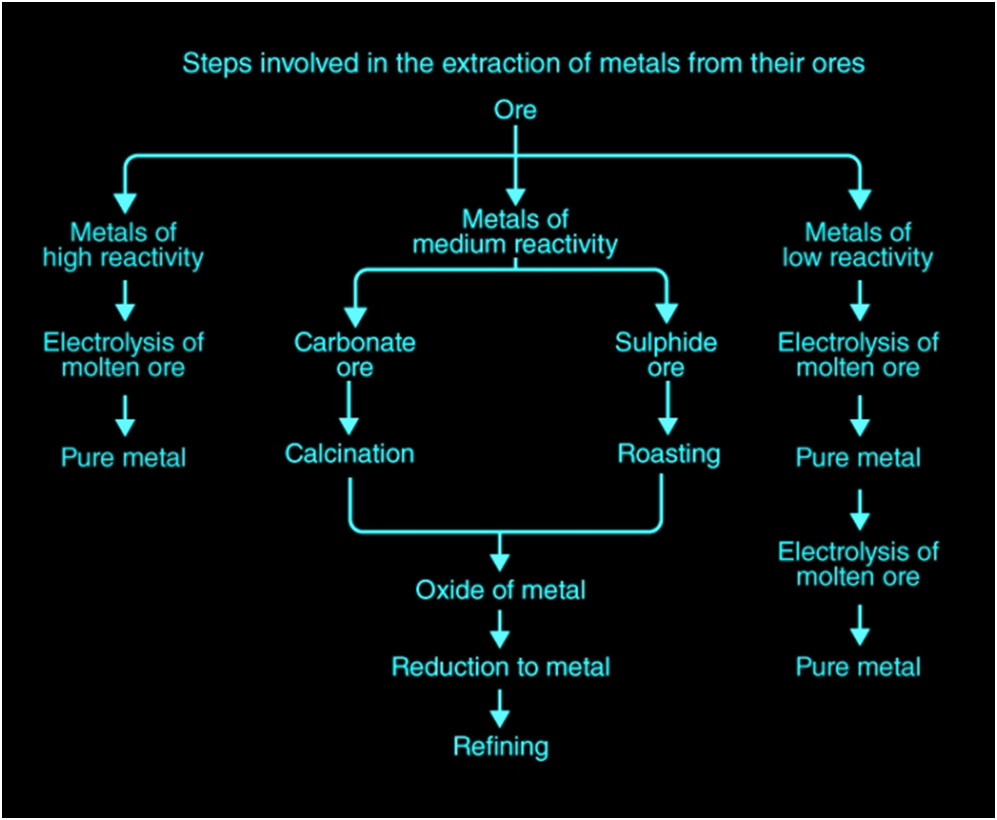
Metals of high reactivity – Na, K, Mg, Al.
Metals of medium reactivity – Fe, Zn, Pb, Sn.
Metals of low reactivity – Cu, Ag, Hg
Roasting
Converts sulphide ores into oxides on heating strongly in the presence of excess air.
It also removes volatile impurities.
2ZnS(s)+3O2(g)+Heat→2ZnO(s)+2SO2(g)
Calcination
Converts carbonate and hydrated ores into oxides on heating strongly in the presence of limited air. It also removes volatile impurities.
ZnCO3(s)+heat→ZnO(s)+CO2(g)
CaCO3(s)+heat→CaO(s)+CO2(g)
2Fe2O3.3H2O(s)+heat→2Fe2O3(s)+3H2O(l)
Extracting Metals Low in Reactivity Series
By self-reduction- when the sulphide ores of less electropositive metals like Hg, Pb, Cu etc., are heated in air, a part of the ore gets converted to oxide which then reacts with the remaining sulphide ore to give the crude metal and sulphur dioxide. In this process, no external reducing agent is used.
1. 2HgS(Cinnabar)+3O2(g)+heat→2HgO(crude metal)+2SO2(g)
2HgO(s)+heat→2Hg(l)+O2(g)
2. Cu2S(Copperpyrite)+3O2(g)+heat→2Cu2O(s)+2SO2(g)
2Cu2O(s)+Cu2S(s)+heat→6Cu(crude metal)+SO2(g)
Extracting Metals in the Middle of Reactivity Series
Smelting – it involves heating the roasted or calcined ore (metal oxide) to a high temperature with a suitable reducing agent. The crude metal is obtained in its molten state.
Fe2O3+3C(coke)→2Fe+3CO2
Aluminothermic reaction – also known as the Goldschmidt reaction is a highly exothermic reaction in which metal oxides usually of Fe and Cr are heated to a high temperature with aluminium.
Fe2O3+2Al→Al2O3+2Fe+heat
Cr2O3+2Al→Al2O3+2Cr+heat
Extraction of Metals Towards the Top of the Reactivity Series
Electrolytic reduction:
1. Down’s process: Molten NaCl is electrolysed in a special apparatus.
At the cathode (reduction):
Na+(molten)+e−→Na(s)
Metal is deposited.
At the anode (oxidation):
2Cl−(molten)→Cl2(g)+2e–
Chlorine gas is liberated.
2. Hall’s process: Mixture of molten alumina and a fluoride solvent usually cryolite, (Na3AlF6) is electrolysed.
At the cathode (reduction):
2Al3++6e–→ 2Al(s)
Metal is deposited.
At the anode (oxidation):
6O2– → 3O2(g)+12e–
Oxygen gas is liberated.
Enrichment of Ores
It means the removal of impurities or gangue from ore, through various physical and chemical processes. The technique used for a particular ore depends on the difference in the properties of the ore and the gangue.
Refining of Metals
Refining of metals – removing impurities or gangue from crude metal. It is the last step in metallurgy and is based on the difference between the properties of metal and the gangue.
Electrolytic Refining
Metals like copper, zinc, nickel, silver, tin, gold etc., are refined electrolytically.
Anode: impure or crude metal
Cathode: a thin strip of pure metal
Electrolyte: aqueous solution of metal salt
From anode (oxidation): metal ions are released into the solution
At cathode (reduction): the equivalent amount of metal from solution is deposited
Impurities deposit at the bottom of the anode.
5. Corrosion
- Books Name
- Chemistry Class 10 NCERT based
- Publication
- Grow Career Publication
- Course
- CBSE Class 10
- Subject
- Chemistry
Corrosion
Alloys
Alloys are homogeneous mixtures of metal with other metals or nonmetals. Alloy formation enhances the desirable properties of the material, such as hardness, tensile strength and resistance to corrosion.
Examples of a few alloys:
Brass: copper and zinc
Bronze: copper and tin
Solder: lead and tin
Amalgam: mercury and other metal
Corrosion
Gradual deterioration of material usually a metal by the action of moisture, air or chemicals in the surrounding environment.
Rusting:
4Fe(s)+3O2(from air)+xH2O(moisture)→2Fe2O3. xH2O(rust)
Corrosion of copper:
Cu(s)+H2O(moisture)+CO2(from air)→CuCO3.Cu(OH)2(green)
Corrosion of silver:
Ag(s)+H2S(from air)→Ag2S(black)+H2(g)
Prevention of Corrosion
Prevention:
1. Coating with paints or oil or grease: Application of paint or oil or grease on metal surfaces keep out air and moisture.
2. Alloying: Alloyed metal is more resistant to corrosion. Example: stainless steel.
3. Galvanization: This is a process of coating molten zinc on iron articles. Zinc forms a protective layer and prevents corrosion.
4. Electroplating: It is a method of coating one metal with another by the use of electric current. This method not only lends protection but also enhances the metallic appearance.

 PRIDE LEARNING PUBLICATION
PRIDE LEARNING PUBLICATION
 Grow Career Publication
Grow Career Publication
